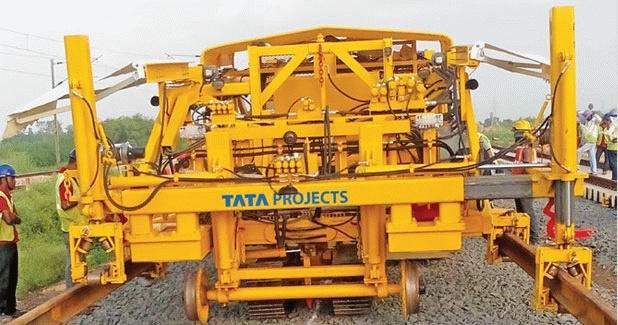
Innovative Track Laying in Railway Construction
Tata Projects Ltd, one of India?s fastest growing and most admired infrastructure companies has commenced work on the Rs 4328 crore project to build the 320-km stretch of the Western Dedicated Freight Corridor, a dedicated freight line connecting Delhi and Mumbai. The company, along with IRCON International Ltd, part of the Express Freight Consortium, which is led by Mitsui & Co, Ltd of Japan. Segregating freight traffic from passenger traffic shall pave the way for high speed movement of freight, and is one of the most important Infrastructure projects taken up by Indian Railways.
Innovative approach
The consortium plans to complete the work in scheduled time of 48 months using latest technology of automated track laying machines. The machine lays the sleepers, special rails imported from Japan, and clamps all together in an automated manner simultaneously. The rails used are special `Head Hardened (HH)? 250 m long rails ? which are welded together using Flash Butt welding machines, creating a smooth track. The axle load of the track would be 32.5 tonne, at par with tracks in Japan, compared to the current Indian rail tracks of 25 tonne axle load. The project is for civil and track works and will be executed in two Contract Packages ? Contract Package 12 between Vaitarana and Sachin (186 km) and Contract Package 13 between Sachin and Vadodara (134 km).
It may be noted that traditionally, small track lengths were used in tracks with fish plated bolted joints for connecting the track lengths at frequent intervals. As a result, the work process was slow and inefficient; frequent joints caused more vibrations; excessive vibrations adversely affected the under carriage components; substantially limited the maximum attainable speed of the rolling stocks and the overall cost of track-laying was high. Using high technical expertise, gained over long experience in railway construction, the consortium developed a special methodology and innovative equipment deployment to lay up to 292 m long, pre-welded and pre-assembled tracks in the western DFC to effectively address all the problem aspects. A very significant and beneficial construction innovation by the consortium!
The Dedicated Freight Corridor (DFC) is an ambitious programme of the Ministry of Railways, Government of India, involving construction of two corridors: The Eastern Dedicated Freight Corridor is from Ludhiana to Dankuni, and the Western Dedicated Freight Corridor from Dadri to Jawaharlal Nehru Port, Mumbai. It is being implemented by Dedicated Freight Corridor Corporation of India Ltd (DFCCIL). The DFC project will eventually link the four hubs of Delhi, Mumbai, Chennai and Kolkata at the corners of India?s Golden Quadrilateral. The Japanese government has provided yen loans for the Western DFC project under the Special Terms for Economic Partnership (STEP). To execute the Western Dedicated Freight Corridor, Tata Projects will leverage its project execution expertise to carry out civil engineering work and lay tracks jointly with IRCON, while Mitsui will provide its established technical expertise.
On this occasion Vinayak Deshpande, Managing Director, Tata Projects Ltd, said, ?We are delighted to be a part of this ambitious Dedicated Freight Corridor project for the second time, as we are already constructing a section of the Eastern Freight Corridor. The early commencement of work, within a short period of the award of contract, is testimony to our proven execution excellence and capabilities in this area. Tata Projects, along with the other consortium partners, aims to bring the best of the technological advancements for this project in line with global standards. This project is an important milestone towards modernisation of India?s rail freight transportation, and we at Tata Projects are committed to the development of India.?
- Vinayak Deshpande, Managing Director, Tata Projects Ltd ?Tata Projects, along with the other consortium partners, aims to bring the best of the technological advancements for this project in line with global standards.?


 +91-22-24193000
+91-22-24193000 Subscriber@ASAPPinfoGlobal.com
Subscriber@ASAPPinfoGlobal.com